

| Rudolf Wittkower says that "Sicily's one great boast" during the late Baroque and Rococo period was Giacomo Serpotta, "a meteor in the Sicilian sky" (458). His fame derives from a number of church interiors, primarily in Palermo, which he decorated with stucco figures. Grady explains that he is "widely credited with bringing the art of moulding stucco to a pitch worthy of the great stone carvers and ushering in the Rococo" (56). He also achieved striking effects of chiaroscuro by adding marble dust while the stucco was still wet. (See also the Oratorio del Rosario in San Domenico on this site.) The name Serpotta means serpent or lizard and Serpotta often punned on his name including snakes or lizards in his works. This oratorio is dedicated to the Rosary with the back wall focussed on the "Glorious Mysteries of the Rosary" and with the central lower relief celebrating the Battle of Lepanto (1571), a victory won by the Christian naval forces over the Ottoman fleet. The Holy League credited the victory to the Virgin Mary, whose intercession with God they had implored through the use of the Rosary. The five "Glorious Mysteries," represented in deeply receding reliefs on this wall are: the Resurrection (left bottom), the Ascension (left top), Pentecost (right bottom), the Assumption of Mary (right top), and the Coronation of Mary (top center). Details of these reliefs are seen below and on the next page. | ||
Center: portrait bust of Serpotta |
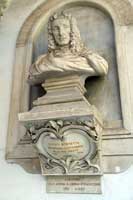
|
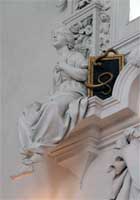
|

|
On this entrance wall an enormous drapery is simulated in stucco, held up by numerous putti who lift the tumultuous drapery from below and behind with a variety of flying and levitating motions. As Wittkower notes, Serpotta was a "master of the putto; playing, laughing, weeping, flying, and tumbling, they accompany every one of the decorations, spreading a cheerful and festive atmosphere" (459). Donald Garstang explains that all the other movement in the room evolves from this wall: "The putti who fly and tumble around the room are, as it were, shaken out of the drapery and take their flight from the clamorous celebration of Catholic victory" (67). The reliefs seem sunken in the drapery. | |

|

|
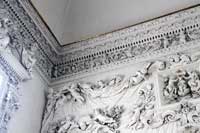
|
The Battle of LepantoThe Virgin, seated on clouds with an entourage of angels, hands the rosary to St. Dominic, who kneels before her. Below, the battle scene is reduced to a manageable number of galleys with parts picked out in gold gild. The victory of Catholic powers over Turks is attributed to the miraculous intervention of the Virgin of the Rosary. | ||

|
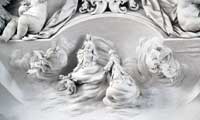
|
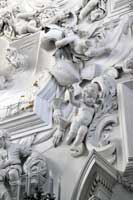
|
The boys below the relief: Center with the Christian boy with his hand resting on a helmet; Right with the Moslem boy holding a turbanGarstang's comment on this relief is interesting: "Their different fortunes are subtly expressed by their faces. The victor's gaze is clear and steadfast whilst the Moslem's face is pinched and harsh. Between them is a large trophy of flags and weapons, including blunderbusses. Tossed in with these as a kind of afterthought is a heroic cuirass. Its stylized and elegant musculature, so at variance with the tender realism of the youths, is a reminder of that sharp contrast between the real world of pain and suffering and that other world of joy and abandon into which we enter to celebrate our successes or to mark aaniversaries of real or imagined victories" (62-3). | ||

|
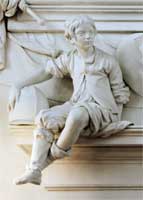
|
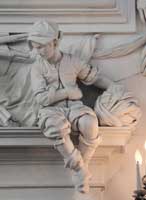
|
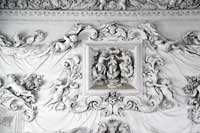
|

|
The Coronation of MaryElegant arabesques frame this top-most relief with putti as part of the framing device as well as a group of roses at the base of the frame. In the deeply recessed relief, the Virgin, seated on clouds, is crowned by the Father and Son. The crown and dove of the Holy Spirit are gilded. |